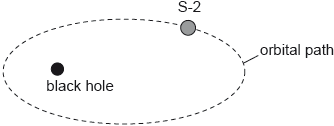| Date | May 2019 | Marks available | 3 | Reference code | 19M.3.HL.TZ2.9 |
| Level | Higher level | Paper | Paper 3 | Time zone | 2 |
| Command term | Explain | Question number | 9 | Adapted from | N/A |
Question
A rocket is accelerating upwards at 9.8 m s-2 in deep space. A photon of energy 14.4 keV is emitted upwards from the bottom of the rocket and travels to a detector in the tip of the rocket 52.0 m above.
Explain why a change in frequency is expected for the photon detected at the top of the rocket.
Calculate the frequency change.
Markscheme
ALTERNATIVE 1
detector accelerates/moves away from point of photon emission ✔
so Doppler effect / redshift ✔
so f decreases ✔
ALTERNATIVE 2
equivalent to stationary rocket on earth’s surface ✔
photons lose «gravitational» energy as they move upwards ✔
h f OR f decreases ✔
Examiners report
Most candidates answered this question correctly using the equivalence principle and could show that the frequency would decrease.
Arithmetic mistakes were common at the different stages of the calculations even when the process used was correct.



